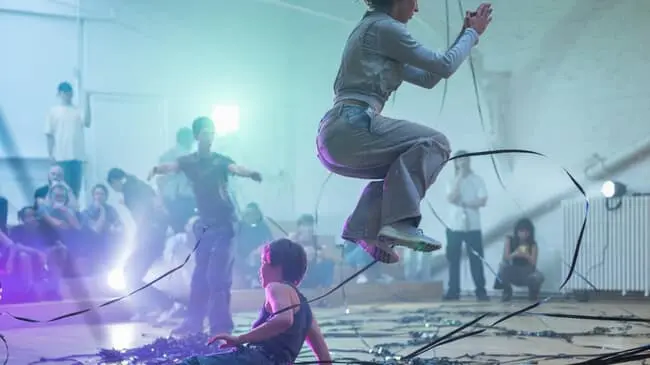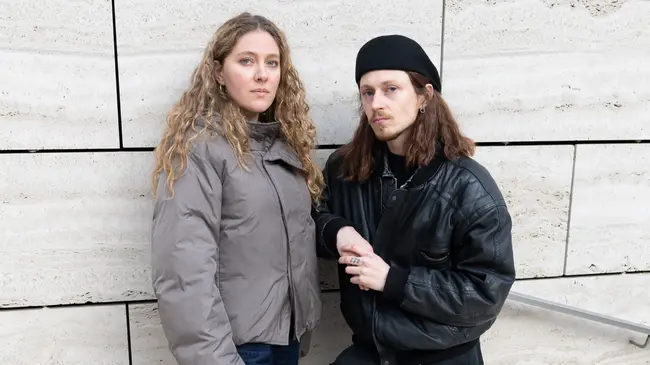Everything begins by telling a story, which is very often related to a nightmarish universe

Wherever painting and theatre come together, you can locate Brussels-based artist Victoria Palacios. Her paintings inhale theatricality and are the outcome of a performative education. She plays with characters, creates visual stories and considers her act of painting as a dance. Her work is much more than what‘s stuck on the wall: it’s an experience, a live event and an assembly of different media. Triggered by two exhibitions that are currently running at KMSKB, Carta Canta by Pierre Alechinsky and Aboriginalities, we walked through her deepest nightmares and met her most intimate painted creatures.
A first impression, how did you experience both exhibitions?
Both exhibitions made me very curious even though it was especially Alechinsky's work that really touched me. Since my arrival in Belgium, I’ve had the opportunity to get to know his work better through various exhibitions. His acrylic paintings have had a huge impact on me and my work. Certainly, his large formats are very powerful: when I walked into the monumental museum hall, I immediately noticed the two gigantic paintings by Alechinsky. They dominated the room among the marble nudes. His works in which he decides to engrave or stamp haven’t affected me as much. Still, it is a pleasure to see that he dares to go for freedom and opts for constant experimentation. I often try to imagine the artist's paths of thought: Alechinsky’s are related to the snake that returns everywhere and every time in his work. You notice a clear hybrid between pure painting, reproduction, montage and comics, and he merges everything into a logical whole.
While I know Alechinsky's work well, it is striking that this is not the case at all with the Aboriginalities exhibition. It bothered me a bit how these works are shown, as they often lose their original meaning. The context partly disappears when they end up in a museum space. For example, I was so surprised to see acrylic on classically embedded canvases, knowing that Aboriginal painting is more likely linked to ephemerality and the context of nature. Non-European art is exhibited too much without taking into account the spiritual involvement and the ceremonial context.
Alechinsky stretches the infinity of imagination by creating his own universe. How would you describe your own universe?
It’s difficult to describe your own universe. I think that, both in aesthetic and theoretical content, there is a theatrical aspect inherent to my work. You’ll probably have to go into my atelier to understand what is happening there. My work is not only about the painting that is stuck on the wall. I try to create fictions whether it is in painting, performance or spatial installations. Everything begins by telling a story, which is very often related to a nightmarish universe. My universe could be seen as an apple with a tooth in it and an earthworm wrapped around it, all on a spider's web. Each story has an impact on the setting and the actors. The setting is not necessarily the painting or the performers or the actors. It can also be the other way around. Everything has equal status, so I try to disturb the roles that already exist.
My universe could be seen as an apple with a tooth in it and an earthworm wrapped around it, all on a spider's web
Some creatures often (re)appear in your work. How did these become part of your personal narrative?
There are indeed some creatures who often intervene in the story of my work. As Alechinsky, I feel the desire to bring mythologies alive on canvas. One mythological or even supernatural creature who often appears in my work is the ‘succubus’. These female demons arouse fear mainly because of the desire we feel for them. There are also some symbols from the theatre who regularly return, like a purple-red curtain or a chessboard which very clearly stages what is happening. These symbols go hand in hand with the carnival figures like the clown and the harlequins. They are always worried even when they are smiling. The clown is very present - my father is a mime clown for a living - so obviously a psycho-analytic connection can be made. (Laughs) The rotten apples floating through the paintings recall the representation of desire and are a fairly evocative emblem. There’s also this white swan which is frequently present. I see it as the hidden symbol of painting and as my personal relationship with painting. The swan has often been represented in classical and romantic imagery in the same way that a certain facet of painting could be represented by this animal, so admired for its beauty while also being a little sly. It has different vertebrae but still the same feathers.
Can your paintings be an escape route from our currently locked down society?
It always touches me when I can enter someone else’s imagination. It allows me to move in a temporality. I always try to communicate indirectly with my work, based on mythologies, (day)dreams or nightmares. Every story is a new reality. It’s not because the reality I refer to is that different from the one we know: more often than not, it’s the more recognizable and typical images that allow us to enter a new imagination. As in my last exhibition, it is always important to not only let the painting determine the gaze of the spectator. Rather it is about looking for spaces that are alive, where light, sound and body are of equal value. I wonder how these elements are connected with the paintings and can be read as part of the sculpture or as the sculpture itself. The assembly of all these elements becomes a choreography, it always takes on a certain duration in a certain space.
I always try to communicate indirectly with my work, based on mythologies, (day)dreams or nightmares
What will the coming months bring you?
Recently I had an exhibition in Brasserie Atlas named L’araignée. Here I tried to build bridges between painting and sound. My intention was to move musicians into the image, making them an integral part of the painting by implementing well-known codes of the theatre. For this project, I worked together with three artists: Maoupa Mazzocchetti, Charlene Darling and Daniel Dariel. All artists, composers, and musicians are my accomplices and actors. Everything is articulated together and cannot act without each other. I saw the exhibition as a movie and set it up like a play. Currently, I am working on a piece where paintings, dance and sound are linked together.
My upcoming projects are very exciting. The soonest will be at the Belgian Biennale, where I was invited by the Panamax collective. We are working on an installation where paintings and sounds will be intertwined.
Different Class works with the interest of their community at heart.
Our work’s purpose is to foster a solid network for independent artists, those who love them, and those who want to support them. Become a member to contribute to the local Belgian art scene.






